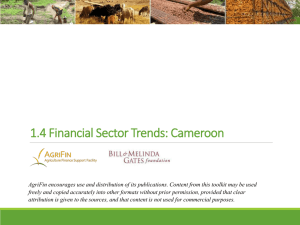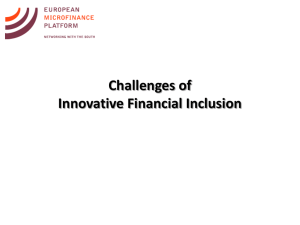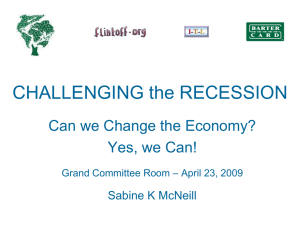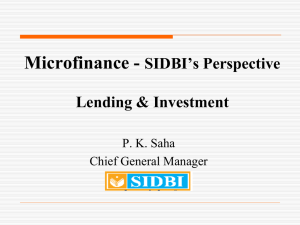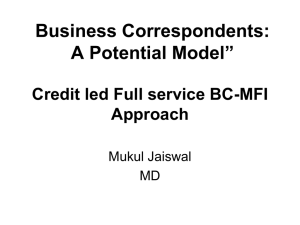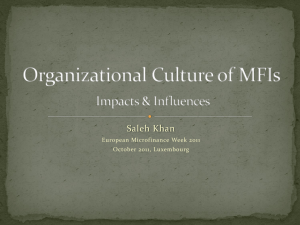micro insurance - Sa-Dhan
advertisement
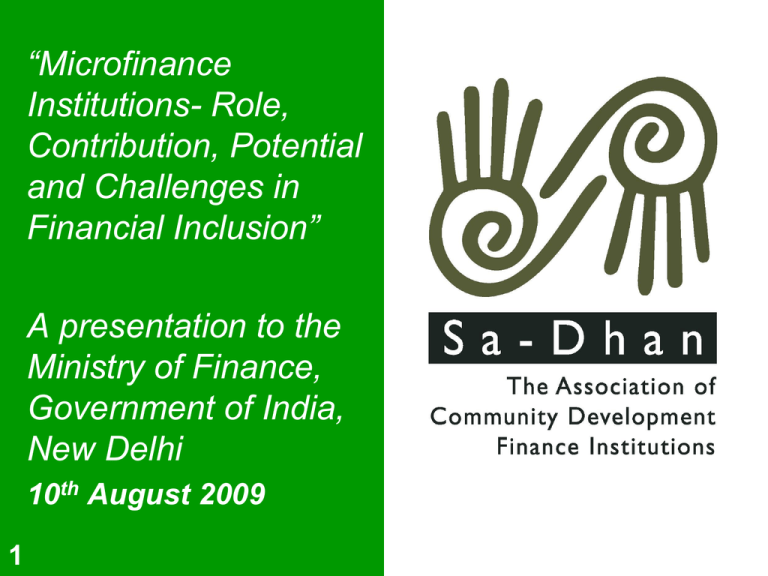
“Microfinance Institutions- Role, Contribution, Potential and Challenges in Financial Inclusion” A presentation to the Ministry of Finance, Government of India, New Delhi 10th August 2009 1 Sa-Dhan in Financial Inclusion On Financial Inclusion, Sa-Dhan members’ - ensure access to financial services - provide timely and adequate credit - to vulnerable groups such as weaker sections and low income groups -at an affordable cost” Dr. Rangarajan’s Committee on “Financial Inclusion” “MFIs could play a significant role in facilitating inclusion, as they are uniquely positioned in reaching out to the rural poor. Many of them operate in a limited geographical area, have a greater understanding of the issues specific to the rural poor, enjoy greater acceptability amongst the rural poor and have flexibility in operations providing a level of comfort to their clientele”. 2 Services Provided by MFIs Though the scope are wide but till now generally the MFIs are providing the services like• Micro Savings • Micro Credit • Micro Insurance • Micro Remittance • Micro Pension 3 MFIs REACH A CRITICAL MASS • • • • MFI now serve 22.6 million clients Loan Portfolio touches INR 12000 cr 93% of MFIs clients are women MFIs serve about 50 lakhs SC/ST borrowers and 29 lakhs of minority background • MFIs have reached to the 71% of the poorest districts, defined by NREGP 1st and 2nd phase • MF sector have generated direct employment of more than 62000 professionally skilled personnel First mile connectivity for the poor &last mile for FFIs 4 Performance and Growth 5 6 Still to achieve • 80% of the poor household are out of full fledged financial services • Many no-frills accounts are reported to be nonfunctional • No access to savings products • 95.5% of MSME excluded from formal banking • Only 14% of lowest income quartile have life insurance • Less than 1% of population appears to have medical insurance • Major source of credit for most Indians is still the moneylender 7 Issues and Concerns: • Issues related to provision of composite financial services • Problems faced by CBOs • Related to not-for-profit MFIs • Related to NBFC-MFIs • Addressing Regional Skewedness • Other important issues 8 Issues related to provision of composite financial services • REMITTANCE – Small Ticket size, Door to Door Service – Not recognised by RBI as a financial product – MFIs should be allowed to do remittance operations • MICRO INSURANCE – Slow progress – main hindrance is the current claim settlement process – move towards a community based process – Adequate marketing channels for Micro Insurance – Need for awareness creation - no support available as Development Cost. – Waive Service Tax to make micro insurance affordable – Increase priority sector targets for micro insurance • MICRO PENSION - Promotion and development needs policy attention 9 Potential of CBOs to Promote Financial Inclusion • CBOs ( SHGs, Federations and New Generation Cooperatives) reach out to the poorest of the poor not covered by other financial institutions • 32 lakh SHGs and 69,000 Federations exist in the country according to NABARD • Financial intermediation role of CBOs, Federations and Cooperatives enables timely accessibility of financial services • CBOs / Federations are both an empowering and equitable tool for the poor. 10 Problems faced by CBOs • Lack of Investment in Capacity Building of SHGs, Federations and Cooperatives – Training – HR – Financial Literacy – Access to Technology • Lack of clarity on the legal and operational structure of CBOs hampers their ability to effectively play the role of financial intermediary. 11 Not- for- Profit MFIs: Recommendations • Recognition to such institutions in Financial Inclusion • Source of funds- Setting up Refinance Institutions, allow savings mobilisation, equity • Reduce Cost of funds • Exemption from Taxation • Develop appropriate legal structures • Special allocation for unreached areas eg. North East and other backward areas. 12 NBFC - MFIs ARE WELL REGULATED ON PAR WITH THE BANKS • Registered with RBI • Follow Prudential Norms stipulated by RBI • Follow KYC Norms applicable in the case of rural borrowers • Adopt Code of Conduct and Fair Business Practices • File regular Returns and subjected to on-site and off –site Inspection by RBI 13 NON-REVENUE MEASURES Representation NBFC - MFIs Pooling of Resources Classify NBFC – MFIs as a separate Precedence – NBFC AFCs category Reduce risk weightage to 25-50% on loans to MFIs Mobile Banking & Correspondent banking to be allowed for MFI- NBFCs Allow MFIs to issue Prepaid cards with ATM access. ECBs MFIs to access External Commercial Borrowings (ECBs) MFIs to access Savings Allow MFIs to accept “Demand Deposit” from members. Long term Funding requirement Rationale Allow ADB / IFC to issue Long Term guarantee to MFIs. Capital allocation of 19% Vs Basel II stipulation of 9% & impeccable asset quality Amalgam of the ‘funding capability’ of banks & ‘credit delivery skills’ of NBFCs. End use Vs structure ‘Credit – Saving – Insurance’ Triangle MFIs need Long Tem money 14 Control Structure for MFI NBFCs • Dispensations only to MFIs registered as NBFC with RBI. • Other stipulations • Ticket size not to exceed Rs 50,000 • Deposit accepted not to exceed loan exposure at the enterprise level • Bank ‘s equity holding in NBFC- MFIs to be capped at 10% • 75% of net interest earning from Micro lending • Dispensation to be linked to supervisory rating 15 REVENUE MEASURES Recommendation Service Tax Exempt Service Tax on all Micro Finance Products including Micro Insurance. Dr.Rangarajan Committee Report 40% tax exemption to MFIs under sec 36 (i)(vii) of the IT Act Provisioning on Nonperforming Assets Provisioning by MFIs on their Non-performing assets be treated as tax deductible expenditure. Stamp Duty Waive Stamp Duty on all Debt issuance of MFI – NBFCs. Rationale The poor is unlikely to avail tax exemptions on insurance premium or interest paid on housing loans, etc. To compensate, waive service tax. Level playing field with HFCs, DFIs, etc. Level playing field with Banks. Reduce cost of delivery of financial services to the Poor. 16 Addressing Regional Skewedness • Lack of Financial infrastructure and technical support in the underserved regions –Credit Guarantee Fund, Capacity Building and promotional funds • Lack of funding support for institution building, systems and innovations, awareness and financial literacy • Lack of professional and well managed a adequate number of service providers • Lack of Region specific rating tools and its recognition • Lack of interest from mainstream FIs in lending local and indigenous institutions 17 Other important issues • Cost of fund is high resulting in higher pricing • Application of State Money Lenders Act and sporadic problems associated with local administration • Lack of Credit information Bureau and information sharing • Credit Guarantee Fund to promote growth of the sector • Exemption from stamp duty on the loan documentation for the MFIs 18 THANKS FOR THE PATIENT HEARING 19

